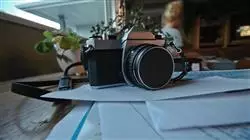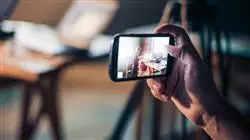University certificate
The world's largest faculty of journalism and communication”
Why study at TECH?
Learn how to quickly and easily convert the photos taken with your cell phone into professional images of quality. Learn how to take advantage of the social networks and the ethical guidelines that must be followed by professionals in photojournalism"

Learn how to make use of the different options that today's cell phones offer the professional photographer, incorporating the most interesting innovations in this field"
Mobile photojournalism has been slowly making its way into the media. Due to the advances in technology and the explosion of the Internet, and our consequent need for instant gratification, smartphones have become a key tool in the day-to-day work of the photojournalist.
Any prejudices against mobile phone photography stem from the fact that the device was grossly misused by newspapers and the like when it was first incorporated into society, mainly because the final decision was always given to the editors who had had no previous training in photography. In addition, the camera's phones features had many shortcomings when compared to SLR cameras. Nowadays, thanks to their technological evolution, they are capable of producing images of a quality worthy of being published in the national and international media.
The advantages and disadvantages of working with a smartphone or with a camera is a factor about which you need to be very clear in order to be efficient in this profession. Knowing in which situations it´s best to use a cell phone, when it is more advantageous than a shot taken with a camera, a mobile phone´s portability and immediacy play a crucial role when weighing up the pros and cons in certain circumstances.
The incorporation of mobile photography into the multimedia era will be explored in depth whilst students will also discover which applications are the most useful for editing and designing images intended for networks or media-based websites.
We also take a look at the well-respected figures of importance in this field, investigating the pioneers of mobile photojournalism and studying the award-winning projects.
In another section we will take a look at mobile phones in photojournalism, from the appearance of the first images on the web right up to the present. To this end, we will study the different informative images that have appeared on the internet, including citizen journalism, a new genre which has important implications in terms of affecting an audience's perception, the way that some media use photojournalism on the social networks and also how prominent photojournalists use their social networking accounts.
In addition, TECH will give an overview of the advantages and disadvantages of the main platforms which are available to professionals and the public for publishing photos. Not only will we analyze the most well-known social networks but also those which deal specifically with photography and in order to complete the overview of networks and applications, some auxiliary tools which can optimize photographer's work will be presented.
Furthermore, we will see the possibilities of marketing our photographs through the through different platforms, which are many and varied, although there is always the option of marketing them ourselves, and we will also see some examples of this. We will take what promises to be a fascinating deep dive into the different ways of presenting your work using image galleries, encompassing the characteristics of the portfolio, the image galleries themselves and photo essays. We will also take a look at the most relevant photographic events in which professionals can participate, including some specialized in smartphone photography.
Finally, and to conclude the module, we will address the verification of content, taking into account that some images have acquired great prominence on the back of the Fake News phenomenon, not only due to the fact that they were used out of context but also because they were often photoshopped or manipulated to suit a specific agenda.
The topic of ethics in photojournalism constitutes is a complex field which is of great interest to specialists and citizens alike. The ethical guidelines to be followed in the field of photography have not be set out or researched as extensively as the written ones, which is why throughout history there have always been confrontations on this subject.
Photography in the media must be truthful and respectful. Because of this, any behavior of manipulation or infringement of the individual's image rights is condemned. Similar situations are being discussed more and more since the advent of the Internet, where it is almost impossible to control the flow of photographs being uploading day by day and the so-called "citizen witness" has carte blanche to publish any image they choose to.
Determining what is and is not acceptable regarding an informative image requires an analysis of the values of the individual and of society as a whole. In this module, photojournalistic ethics are approached from different perspectives using real cases. This will make it possible to differentiate between different debates: the manipulation of the image, the rights of the individual and the viewer's sensibilities.
Clarifying certain expert's stances on the most controversial subjects helps to build up one's own idea of what is or is not acceptable in photographs of a sensitive nature that deal with for example: children, immigrants or situations of humanitarian crisis or conflict.
In addition, the fat that there are cases that have overcome the limits of the image (in comics) opens a pathway to greater levels of creativity and innovation in photography and ethics. The property rights which concern how to use images legally and attribute the authorship of the projects will also be covered.
A highly specialized Postgraduate diploma that includes the most innovative and efficient technology available for taking photographs from mobile devices and the most widely used apps"
This Postgraduate diploma in Mobile Photojournalism, Social Networking and Photographic Ethics contains the most complete and up-to-date academic course on the university scene. The most important features of the program include:
- The latest technology in online teaching software
- A highly visual teaching system, supported by graphic and schematic contents that are easy to assimilate and understand
- Practical cases presented by practising experts
- State-of-the-art interactive video systems
- Teaching supported by telepractice
- Continuous updating and recycling systems
- Autonomous learning: full compatibility with other occupations
- Practical exercises for self-evaluation and learning verification
- Support groups and educational synergies: questions to the expert, debate and knowledge forums
- Communication with the teacher and individual reflection work
- Content that is accessible from any fixed or portable device with an Internet connection
- Banks of complementary documentation permanently available, even after the course
Gain a deeper understanding of the advantages and disadvantages of using cell phones to take pictures and add an extra layer of quality to your skill set"
The team of teachers on the Postgraduate diploma in Mobile Photojournalism, Social Networking and Photographic Ethics has extensive experience in teaching at university, both at undergraduate and graduate level , alongside their extensive experience as working professionals. The faculty's direct experience, their knowledge, as well as their analytical capacity are the best resources available to you in order to grasp the keys to the present and the future of an exciting profession for those who love sports and communication.
The methodology of TECH Technology University's Postgraduate diploma, a 100% online format, makes it easy for students to balance their studies along with their work and their personal lives.
This educational compendium makes this Postgraduate diploma a degree of specialization that compiles all the aspects that are relevant and essential to turning the Journalism professional into authentic experts in their profession.
Essential knowledge for professionals in the fields of journalism and photography, helping them to avoid being left behind by the pack"

You will learn about the work that has become a benchmark in the profession, learning from them through thorough analysis"
Syllabus
The content on this training course will allow you to learn all aspects of the different disciplines involved in this area with a very complete and well-structured program that will take the student to the highest standards of quality and success. A complete review that will take the student to the highest level in a stimulating and intensive way.

A very complete syllabus, organized in such a way that your learning is constant, stimulating and very efficient, converting your effort into valuable working skills"
Module 1. Mobile Photojournalism
1.1. The Multimedia Era
1.1.1. The Importance of Mobile Photojournalism
1.1.2. The Presence of Mobiles in the Media
1.1.3. Technological Advances in Devices
1.1.4. Internet and Social Media
1.1.5. Mobile Photo Group
1.2. Technical Characteristics of Smartphones
1.2.1. Pixels
1.2.2. Focal Aperture
1.2.3. Dual Camera
1.2.4. Screen
1.2.5. Camera Options
1.3. Pros and Cons of Mobile Photography
1.3.1. Portability: Size and Weight
1.3.2. Immediacy
1.3.3. Image Quality
1.3.4. Temporary Efficiency
1.3.5. Flash
1.3.6. Panoramic
1.3.7. Zoom
1.3.8. Photographs that Exist Thanks to Mobile Phones (Pandemic, Franco's Exhumation)
1.4. Accessories
1.4.1. Adaptable Targets
1.4.2. Tripods
1.4.3. Covers
1.4.4. Flash’s
1.4.5. Printer
1.4.6. Gimbal
1.5. Technique and Typology
1.5.1. Lighting
1.5.2. Grid
1.5.3. Don´t Use Zoom
1.5.4. Creativity: New Challenges
1.5.5. Street Photography
1.5.6. Frame Photography
1.5.7. Night Photography
1.6. Camera Applications
1.6.1. Advantages
1.6.2. Free and Paid
1.6.3. Manual Camera: DSLR Professional Camera
1.6.4. Open Camera
1.7. Editing Applications
1.7.1. Advantages
1.7.2. Free and Paid
1.7.3. VSCO
1.7.4. Pixlr
1.8. Snapseed
1.8.1. Brightness, Light and Saturation
1.8.2. Brush
1.8.3. Blurring
1.8.4. Curves
1.8.5. Stain Remover
1.8.6. Details
1.9. From Photography to Multimedia Presentation
1.9.1. Design
1.9.2. Free and Paid
1.9.3. StoryChic
1.9.4. Strory Lab
1.9.5. Mojo
1.9.6. Story Maker
1.9.7. Unfold
1.10. References
1.10.1. Pioneers
1.10.2. Awarded
1.10.3. Projects
Module 2. Social Networks and Verification in Photojournalism
2.1. Beginnings of Photojournalism on the Web
2.1.1. Arrival of Image to the World Wide Web
2.1.2. Storytelling and Citizen Photojournalism
2.1.3. The Smartphone and the Democratization of the Image
2.2. Photojournalism in National and International Media
2.2.1. BBC
2.2.2. The New York Times
2.2.3. The Guardian
2.2.4. Le Figaro
2.2.5. El País
2.2.6. La Vanguardia
2.2.7. El Mundo
2.3. Photojournalism in Social Media
2.3.1. Javier Bauluz
2.3.2. Victoria Iglesias
2.3.3. Miguel Riopa
2.3.4. Emilio Morenatti
2.3.5. Manu Bravo
2.3.6. Judith Prat
2.3.7. Luis Calabor
2.4. General Networks and Apps with Photo Publishing
2.4.1. Twitter
2.4.2. Facebook.
2.5. Specific Photography Apps and Networks
2.5.1. Instagram
2.5.2. Pressgram
2.5.3. Flickr
2.5.4. Pinterest
2.5.5. Others
2.6. Auxiliary Tools
2.6.1. StoryChic
2.6.2. Leetags
2.6.3. Adobe Spark
2.6.4. Grid in Instagram
2.6.5. Content Programming Tools
2.7. Sales and Image Distribution
2.7.1. Shutterstock
2.7.2. Adobe Stock
2.7.3. Gettyimages
2.7.4. Dreamstime
2.7.5. 123RF
2.7.6. Depositphotos
2.8. Online Image Galleries
2.8.1. Portfolios
2.8.2. Image Galleries
2.8.3. Photo-Essay
2.9. Main Events in Photojournalism
2.9.1. World Press Photo
2.9.2. Magnum Photography Awards
2.9.3. Leica Oskar Barnack Award
2.9.4. Robert Capa Gold Medal
2.9.5. Mobile Photo Awards
2.9.6. Digital Camera Photographer of the Year (Mobile Section)
2.9.7. iPhone Photography Awards (News/Events)
2.10. Image Verification Tools
2.10.1. Manual Verification
2.10.2. Verification Tools
2.10.3. Fake news Tools
Module 3. Image Rights in Photojournalism
3.1. The Limits of Photography
3.1.1. Introduction to the Concept
3.1.2. Historical Cases
3.1.3. "Citizen Witness: Does Anything Go on the Internet?
3.2. The Code of Conduct
3.2.1. Writing as a Pivot: Unspecified Photography
3.2.2. Public Interest or Interest of the Public
3.2.3. Money before Ethics: Morbidity
3.2.4. Sexualize
3.2.5. Correcting Errors
3.3. Handling
3.3.1. Editing
3.3.2. Temporal
3.3.3. Case Studies
3.4. Image Rights
3.4.1. Constitution
3.4.2. Dignity
3.4.3. Case Studies
3.5. The Eternal Debate: To Show the Reality or Sensitivity of the Viewer
3.5.1. Viewer Protection
3.5.2. Economic Interests of the Media
3.5.3. Expert Opinions
3.5.4. Case Studies
3.6. Children in Images
3.6.1. Child Protection
3.6.2. When Information Takes Priority: The Aylan Case
3.7. Immigrants
3.7.1. Presentation of a Minority
3.7.2. Case Study: Bauluz-Espada
3.8. Intentionality of the Image
3.8.1. Manipulation in Taking the Photograph
3.8.2. Selective Focus
3.8.3. Shots
3.8.4. Angles
3.8.5. Characters
3.8.6. Color
3.8.7. Selection of Agency Images
3.8.8. Literacy: Aesthetic Dimension The Need to Be Critical in the Face of the Image
3.9. Security Forces
3.9.1. Article of the Mordaza Law
3.9.2. Historical Cases
3.9.3. Ethical and Safe Guide to Palika Makam
3.10. Copyright
3.10.1. Know Properties Rights
3.10.2. Consistent Use of Other People's Work
3.10.3. Photography Protection

Learn, practice and position your CV amongst the most competitive in the sector”
Postgraduate Diploma in Mobile Photojournalism, Social Networking and Photographic Ethics
Mobile Photojournalism has gained ground in the media due to technological evolution and the need for speed in publishing news on the Internet. Although there were initial prejudices about the quality of images captured by Smartphones, this has changed thanks to the improvement of these devices. As such, today they already have a quality good enough to be published in the media, so this Postgraduate Diploma in Mobile Photojournalism, Social Networking and Photographic Ethics gains even greater value.
Get the keys to take photos with your Smartphone that will stand out in the media
With this Postgraduate Diploma in Mobile Photojournalism, Social Networking and Photographic Ethics you will delve into the integration of Mobile Photography in the multimedia era, exploring the most useful applications for editing and designing images destined for social networks or media websites. In addition, the references of this specialization will be examined, including the pioneers of Mobile Photojournalism and award-winning projects. All this and more will be available to students in a 100% online format in which they will be able to self-manage their study sessions. Not only will you decide how long they will last, but you will also be able to distribute them over time according to your personal and professional obligations. In addition, you will benefit from having Relearning as a methodological substrate to quickly internalize all topics.







